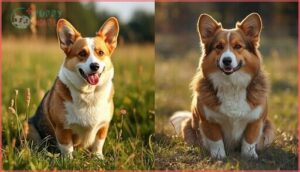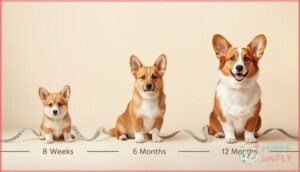This site is supported by our readers. We may earn a commission, at no cost to you, if you purchase through links.
Those stubby legs and long bodies make Corgis look like they’re built from mismatched parts, but there’s nothing random about their size. Pembroke and Cardigan Welsh Corgis both max out around 12 inches tall at the shoulder, though they pack a surprising amount of weight—up to 38 pounds—into their compact frames. That’s dense muscle designed for herding cattle, not just cuteness.
If you’re considering a Corgi or watching your puppy grow, you’ll want to know what to expect at each stage. Growth happens fast in the first year, and understanding the timeline helps you spot potential health issues early and keep your dog at a healthy weight. Their unique body proportions mean standard “small dog” advice doesn’t always apply.
Table Of Contents
- Key Takeaways
- How Big Do Corgis Get?
- Corgi Growth Timeline: From Puppy to Adult
- Corgi Weight and Height Chart by Age
- Factors That Influence Corgi Size
- Pembroke Vs. Cardigan: Size Differences Explained
- Maintaining a Healthy Weight for Corgis
- When Do Corgis Stop Growing?
- Monitoring Your Corgi’s Growth and Health
- Frequently Asked Questions (FAQs)
- What is the average lifespan of a corgi?
- How often should I bathe my corgi?
- What is the best diet for a corgi?
- How much exercise does a corgi need daily?
- Can corgis be trained to herd?
- Do Corgis need special harnesses for their body shape?
- How much daily food should adult Corgis eat?
- Can Corgis jump on furniture safely at full size?
- Conclusion
Key Takeaways
- Corgis reach their full height of 10-12 inches by around 12 months old, but they continue filling out with muscle and weight until about 2 years of age, with Pembrokes typically weighing 24-32 pounds and Cardigans ranging from 25-38 pounds.
- Their unique long body and short legs make them especially vulnerable to obesity and spinal problems like intervertebral disc disease, so maintaining a healthy weight through portion control and 60-90 minutes of daily exercise isn’t optional—it’s preventive medicine.
- Genetics set the blueprint for your Corgi’s size, but nutrition, exercise, and the timing of spaying or neutering (ideally after 12 months) significantly impact their joint health, weight, and overall development.
- Regular vet checkups during the first year help you catch growth issues early, and monitoring weight every 2-3 weeks as a puppy ensures your Corgi stays on track without tipping into the obesity that affects over half of inactive dogs in this breed.
How Big Do Corgis Get?
If you’re thinking about bringing a Corgi into your home, one of the first questions you’ll probably ask is how big they actually get. These adorable dogs are famous for their short legs and long bodies, but their size can vary depending on which breed you’re looking at.
Let’s break down the specific size standards for both Pembroke and Cardigan Welsh Corgis, plus what differences you can expect between males and females.
Pembroke Welsh Corgi Size Standards
The Pembroke Welsh Corgi breed standard sets clear expectations for your pup’s adult size. Males and females commonly stand 10 to 12 inches at the shoulder, with their body length about 40% greater than their height. Weight guidelines recommend 27–30 pounds for males and 25–28 pounds for females, ensuring your Corgi maintains those adorable, balanced proportions.
As a breed, Corgis are prone to cystinuria, so regular veterinary checkups are essential.
Cardigan Welsh Corgi Size Standards
Cardigan Welsh Corgis stand slightly taller than their Pembroke cousins—your Cardigan will reach 10.5 to 12.5 inches at the shoulder. Males generally weigh 30–38 pounds, while females come in at 25–34 pounds. What really sets Cardigans apart is their body length-to-height ratio of 1.8:1, creating that signature elongated silhouette. Their sturdy bone structure and distinctive large, rounded ear shape complete the breed’s balanced, powerful appearance.
As members of the Herding Group, they’ve innate skills.
Male Vs. Female Size Differences
Sexual dimorphism in Corgis is subtle but measurable. Male Corgis generally reach 26–32 pounds and 10–12 inches, while females settle at 24–28 pounds and stay closer to 10 inches. Males develop broader chests and greater muscle mass, giving them a stockier frame.
Growth rates differ too—males gain weight more rapidly between 6 and 12 months, and their caloric needs remain higher throughout adulthood.
Corgi Growth Timeline: From Puppy to Adult
Watching your Corgi grow from a tiny puppy into a full-grown adult is one of the most rewarding experiences of dog ownership. Understanding what to expect at each stage helps you provide the right care and recognize whether your pup is developing on track.
Let’s walk through the key milestones in your Corgi’s growth journey.
8. Week-Old Corgi Size and Weight
Your adorable Corgi puppy enters a fascinating growth phase at eight weeks old. This important puppy weight marker helps you track healthy development from the start.
At this age, expect:
- Typical weight of 8–10 pounds for Pembroke males, 7–9 pounds for females
- Expected height of 4–6 inches at the shoulder
- Noticeable elongated torsos showing their signature proportions
- Weekly gains of about 0.75–1 pound
- Breed variations with Cardigans slightly lighter initially
Schedule veterinary checks to confirm your Corgi puppy growth aligns with standard Corgi size and weight patterns.
6. Month-Old Corgi Milestones
By six months, your Corgi puppy’s growth hits a major turning point—this marks the end of the most dramatic growth spurt. Key growth milestones at this stage include reaching 17–24 pounds and 11–13 inches tall, roughly 75% of their adult size.
| 6-Month-Old Corgi | Development Markers |
|---|---|
| Weight Range | 17–24 pounds (7.7–10.9 kg) |
| Height at Shoulder | 11–13 inches (28–33 cm) |
| Teething Phase | Nearly complete adult teeth |
| Exercise Needs | 30–60 minutes daily |
| Sexual Maturity | Males approaching, females soon after |
This teething phase wraps up as permanent teeth emerge. Exercise needs increase to 30–60 minutes daily, while sexual maturity begins in males around now.
1. Year-Old Corgi Development
At twelve months, your Corgi reaches a significant growth stage. Height plateaus around 10–12 inches, marking physical milestones like training completion and behavioral changes. Weight distribution stabilizes between 22–30 pounds for Pembrokes, though Cardigans reach 35–38 pounds.
Key growth milestones include muscle development and coat maturity. Veterinary monitoring confirms healthy Corgi puppy growth stages align with your Corgi Growth Weight Chart expectations, ensuring proper development throughout these important Corgi growth stages.
2. Year-Old Corgi: Full Maturity
By two years, your Corgi reaches full physical maturity. Adult weight ranges settle between 24–30 pounds for female Pembrokes and 26–34 pounds for males, while Cardigans weigh more. Height remains at 10–12 inches for Pembrokes.
Growth completion signs include:
- Stable weight over several months
- Developed muscle tone throughout body
- Filled-out chest and broader shoulders
- Mental maturity showing calmer behavior
- Consistent appetite without growth spurts
Breed size comparison shows Cardigans larger overall. Post-growth exercise maintains ideal weight, preventing obesity risks common in adult Corgis.
Corgi Weight and Height Chart by Age
Watching your Corgi grow is exciting, but it helps to know if your pup is on track. Every dog develops at their own pace, though most follow a predictable pattern through puppyhood to adulthood.
Let’s look at what you can expect at each stage so you can monitor your Corgi’s progress with confidence.
Tracking Your Corgi’s Growth Progress
Think of monitoring your Corgi puppy’s growth like checking mile markers on a road trip—it helps you know you’re heading in the right direction. Most veterinarians recommend weighing your pup biweekly during the first six months, then monthly through maturity.
You can track growth stages using breed charts that outline healthy indicators at each point.
Expected Weight Ranges at Key Stages
Your Corgi’s weight progression follows a predictable pattern that’s easy to track using a growth monitoring tips chart. During the first year, puppy weight gain accelerates quickly—from 7-9 pounds at eight weeks to 22-34 pounds by twelve months. Then, an adult weight plateau occurs as your Corgi fills out through year two, reaching 26-38 pounds.
| Age | Weight Range |
|---|---|
| 8 Weeks | 7-9 lbs |
| 6 Months | 17-23 lbs |
| 1 Year | 22-34 lbs |
| 2 Years | 26-38 lbs |
Breed size variations and sex-based differences mean males generally weigh more than females throughout development.
Factors That Influence Corgi Size
Your Corgi’s final size isn’t written in stone from birth. Several key factors work together to determine whether your pup stays on the smaller side or reaches the upper end of the breed standard.
Let’s look at what shapes your Corgi’s growth from puppyhood to full maturity.
Genetic Impact on Growth
Your Corgi’s genetic makeup acts like a blueprint, determining much of their adult size. The FGF4 gene creates their signature short legs through chondrodysplasia mutations, while parental influence is your best predictor of eventual size.
Genetic diversity varies between breeds, and screening mutations helps identify IVDD risk and other Corgi genetic health problems. This genetic condition affects not just appearance, but overall development and longevity.
Nutrition and Diet Effects
While genetics set the stage, what you feed your Corgi determines whether they reach their healthy potential or tip into obesity. High-quality dog food matters more than you might think—especially during puppyhood when proper nutrition shapes lifelong development.
Here’s your diet recommendations checklist:
- Calorie requirements: Your 10 kg adult needs 400-500 calories daily, adjusted for activity level
- Protein importance: Quality proteins build and maintain muscle throughout all life stages
- Feeding frequency: Puppies thrive on multiple small meals; adults do well with two balanced portions
- Supplements guide: Consider fish oil for joints and bone broth for hip support
Obesity risks run high in this food-motivated breed, so portion control isn’t optional—it’s preventive medicine.
Exercise and Physical Activity
Just as important as what you feed your Corgi is how much you move them. Adult Corgis need 1-2 hours of daily exercise to maintain a healthy weight and prevent obesity—which affects 56% of inactive dogs in this breed.
Your puppy requires shorter bursts: 30-45 minutes total in 10-minute sessions.
Structured walks, swimming, and fetch aren’t luxuries—they’re preventive medicine that extends lifespan by nearly two years.
Spaying and Neutering Considerations
Beyond diet and movement, your spay or neuter decision directly affects Corgi physical development. Early procedures before six months triple the risk of intervertebral disc disease—a hereditary spinal condition this breed already faces.
Here’s what the research shows about preferred timing:
- Joint health: Sterilization before one year increases hip dysplasia and cruciate ligament injuries threefold
- Metabolic changes: Expect a 20-30% reduction in calorie needs within 2-3 months post-surgery
- Cancer risks: Early neutering raises hemangiosarcoma risk 2-5 times, though spaying before first heat drops mammary tumor risk to 0.5%
- Behavioral impacts: Sexual maturity before sterilization promotes healthier skeletal proportions
- Optimal timing: Wait until after one year for females (or three months post-first heat) and six months minimum for males
Most vets now recommend delaying these procedures until your Corgi reaches skeletal maturity. This patience protects against growth plate disruptions that alter bone proportions and increase orthopedic diseases.
You’ll need to adjust portions immediately after surgery—that 25-pound Corgi drops from 1,476 to 1,230 daily calories to prevent the obesity that affects neutered dogs three times more often.
Pembroke Vs. Cardigan: Size Differences Explained
While both Corgi breeds share that iconic low-to-the-ground build, they aren’t quite twins when it comes to size. The Pembroke and Cardigan each have their own distinct physical traits that set them apart beyond just their tails.
Let’s break down the key differences you’ll notice between these two beloved breeds.
Physical Characteristics of Each Breed
You’ll notice some striking physical differences when you compare these two breeds side by side. The Pembroke Welsh Corgi breed features smaller, pointed ears and a docked or naturally short tail, creating a sleek appearance. In contrast, Cardigans sport larger, rounded ears and a distinctive fox-like tail that extends below the hock.
Body proportions differ too—Pembrokes have a rectangular outline, while Cardigans appear more substantial with heavier bone structure and a broader chest. The Cardigan’s front feet turn slightly outward, balancing their wider shoulder assembly, whereas Pembroke forefeet point straight ahead.
| Feature | Pembroke | Cardigan |
|---|---|---|
| Ears | Smaller, pointed | Larger, rounded |
| Tail | Short/docked | Long, fox-like |
| Build | Lighter, refined | Heavier, substantial |
Weight and Height Comparisons
How much does breed and gender actually impact your corgi’s final dimensions? The numbers tell a revealing story. Adult Pembrokes generally reach 22 to 31 pounds, while Cardigans carry more weight at 25 to 38 pounds. Height ranges overlap considerably—both breeds stand 10 to 13 inches at the shoulder, though Cardigans lean toward the taller end.
Gender variance matters too. Males average 2 to 4 pounds heavier than females across both breeds.
| Measurement | Pembroke | Cardigan |
|---|---|---|
| Male Weight | 26-32 lbs | 30-38 lbs |
| Female Weight | 24-28 lbs | 25-34 lbs |
| Adult Height | 10-12 inches | 10-13 inches |
Maintaining a Healthy Weight for Corgis
Keeping your Corgi at a healthy weight isn’t just about looks—it’s about giving them a longer, more comfortable life. Their unique body shape makes them especially vulnerable to weight-related health problems, so understanding what they need is key.
Let’s walk through the key elements of maintaining your Corgi’s ideal weight, from what the numbers should look like to how you can help them stay fit and healthy.
Ideal Weight Ranges for Adult Corgis
Your adult Pembroke Corgi should weigh 27-30 pounds if male, or 25-28 pounds if female, according to AKC breed standards. Cardigan Welsh Corgis are naturally larger—males usually reach 30-38 pounds, while females weigh 25-34 pounds.
These weight proportions matter because they’re designed to support your Corgi’s unique body structure. You’ll want to maintain proper body condition where you can feel their ribs without excess fat covering.
Risks of Obesity in Corgis
Because Corgis carry their weight on short legs and long spines, obesity hits them especially hard. Excess pounds increase joint damage risk threefold and can lead to heart disease, with abdominal fat raising cardiovascular odds by five times. Your Corgi’s diabetes risk more than doubles when overweight.
Behavioral issues also climb—overweight dogs are 1.7 times likelier to guard food or show fearfulness. Proper weight management truly extends your dog’s life.
Balanced Diet Requirements
What goes into your Corgi’s bowl matters more than you might think. A balanced Corgi diet and nutrition plan should include 18–25% protein intake for adults and appropriate fat content between 10–20%. Don’t overlook fiber balance for digestive health, plus essential vitamins/minerals like calcium and phosphorus.
High-quality dog food promotes Corgi health and wellbeing, though supplementation with omega-3s can benefit joints. Puppy diet needs differ—consult your vet about proper dog diet formulations.
Exercise Needs for Weight Management
Think of exercise as your Corgi’s secret weapon against extra pounds. Daily exercise for weight management requires commitment:
- Aim for 60 minutes minimum – Adult Corgis need purposeful activity at moderate exercise intensity, split into two sessions
- Choose low-impact options – Brisk walks and swimming protect joints while burning calories
- Make it consistent – Structured programs beat sporadic activity patterns every time
Cutting sedentary time makes all the difference in dog exercise success.
When Do Corgis Stop Growing?
Understanding when your Corgi reaches full size helps you set realistic expectations and plan for their long-term care. The growth timeline isn’t as straightforward as you might think—your pup hits different milestones at different ages.
Let’s break down what happens at each stage so you know exactly what to expect.
Height Maturity at 1 Year
By the time your Corgi celebrates their first birthday, they’ve largely reached their full adult height. Most Corgis hit their breed-standard height between 9 and 12 months, with males generally standing 12–13.5 inches at the shoulder and females measuring 10.5–12 inches. This height range aligns perfectly with official breed standards, and regular growth monitoring through pediatric health check-ups confirms they’re on track.
| Gender | Average Height at 1 Year | Height Range |
|---|---|---|
| Male | 12–13.5 inches | 10–12 inches |
| Female | 10.5–12 inches | 9–11 inches |
| Both | Standard full-grown Corgi | Minimal variance |
Weight Development Through Year 2
While your Corgi reaches full height by their first birthday, weight development continues through year two as muscle development and fat distribution mature. Most Pembrokes reach 26–34 pounds (males) or 24–30 pounds (females) by age two, while Cardigans generally weigh 30–38 pounds. Regular weight monitoring every 2–3 months helps with obesity prevention during this critical growth phase.
Here’s what happens during your Corgi’s second year:
- Skeletal maturity completes around 12–14 months when growth plates close
- Muscle mass increases visibly in chest and abdominal areas through month 24
- Metabolic rate decreases after 18 months, requiring feeding adjustments
- Body condition score should stabilize at 4–5 on a 9-point scale
- Adult feeding routine of two measured meals daily prevents weight gain
Physical Vs. Mental Maturity
While skeletal development wraps up by 12 months, your Corgi’s behavioral maturity lags behind—often taking 2–3 years to fully stabilize. This maturity difference means you’ll see adult size long before consistent adult behavior emerges.
The socialization period (7 weeks to 4 months) shapes long-term temperament, but expect renewed independence testing between 1.5–3 years as your pup’s personality solidifies and training impact becomes permanent.
Monitoring Your Corgi’s Growth and Health
Keeping tabs on your Corgi’s growth isn’t just about checking boxes—it’s about catching potential issues early and making sure your pup develops into a healthy adult. You’ll want to know what normal looks like at each stage so you can spot anything that seems off.
Let’s walk through the key areas you should monitor as your Corgi grows.
Regular Veterinary Check-ups
Scheduling annual veterinary care gives your corgi the best chance at a long, healthy life. Your veterinarian will track growth patterns, check for breed predispositions like hip issues, and catch problems early.
Each visit generally covers:
- Weight assessment and nutritional needs review
- Vaccination schedules and parasite prevention updates
- Dental health screening and joint mobility evaluation
These check-ups protect your pup’s canine health and support early detection of treatable conditions.
Signs of Healthy Development
Beyond regular check-ups, you’ll want to watch for clear markers of healthy development at home. Your Corgi puppy should show steady weight gain—increasing from roughly 8-11 pounds at two months to 21-24 pounds by six months.
A thick, glossy coat and sturdy muscle strength during play signal proper growth. Consistent activity levels, curiosity, and normal digestive health round out the picture of thriving Corgi puppy care.
Health Conditions Affecting Growth
While most Corgis grow predictably, certain health conditions can disrupt normal development. Watch for these Corgi growth disorders that may signal deeper health concerns:
- Genetic disorders like the FGF4 gene mutation causing skeletal abnormalities in 100% of purebred Corgis
- Joint dysplasia affecting 8-12% of the breed population
- Nutritional imbalances from improper calcium-to-phosphorus ratios
- Endocrine issues including hypothyroidism slowing metabolic growth processes
Frequently Asked Questions (FAQs)
What is the average lifespan of a corgi?
Most Corgis live 12 to 15 years with proper care. Pembrokes average 12-13 years, while Cardigans often reach Genetics, diet, exercise, and regular vet visits greatly impact their longevity and overall health.
How often should I bathe my corgi?
While frequent bathing seems caring, it actually harms your Corgi’s skin health. Aim for every 1–2 months, using dog-specific shampoo.
Between baths, weekly brushing and spot cleaning maintain coat hygiene without stripping natural oils.
What is the best diet for a corgi?
Your Corgi needs high-quality protein (5% for puppies, 18% for adults), balanced fats, and controlled portions. Breed-specific diets support weight management, while raw feeding offers natural nutrition.
Choose premium dog food suited to their growth stage.
How much exercise does a corgi need daily?
Your Corgi needs 60 to 90 minutes of daily exercise split into multiple sessions. This activity includes brisk walks, interactive games, and mental stimulation to maintain healthy weight and prevent behavioral issues.
Can corgis be trained to herd?
Yes, you can train corgis to herd—their historical herding instinct remains strong. Using positive reinforcement and structured sessions with livestock, these herding dogs learn movement-based cues quickly, often mastering basic tasks within weeks.
Do Corgis need special harnesses for their body shape?
Despite their sturdy build, Corgis face unique fitting challenges with standard harnesses. Their long torso and short legs demand breed-specific harnesses.
Y-shaped designs prevent IVDD and support healthy mobility while accommodating their distinctive body shape.
How much daily food should adult Corgis eat?
Adult Corgis need about 500–750 calories daily—roughly 5 to 2 cups of high-quality dog food split into two meals.
Adjust portions based on activity level, weight management goals, and your dog’s individual dietary needs.
Can Corgis jump on furniture safely at full size?
While full-grown Corgis can physically jump onto furniture, veterinary recommendations suggest limiting jumps to 12 inches. Their long bodies create spinal health risks, making ramps or stairs the safer choice for injury prevention.
Conclusion
Good things come in small packages, and Corgis prove that every day. Now you know how big Corgis get—those 12-inch frames carrying up to 38 pounds of herding muscle.
Watch your puppy’s growth closely during that critical first year, keep their weight in check, and schedule regular vet visits. Their compact build makes them prone to joint issues, so maintaining a healthy weight isn’t optional.
You’re equipped to raise a thriving Corgi.
- https://www.hillspet.com/dog-care/dog-breeds/welsh-corgi-pembroke
- https://iheartdogs.com/male-female-corgi-weights-heights-by-age/
- https://articles.hepper.com/corgi-growth-weight-chart/
- https://www.pawlicy.com/blog/corgi-growth-and-weight-chart/
- https://a-z-animals.com/animals/welsh-corgi/corgi-facts/male-v-female-corgi/














